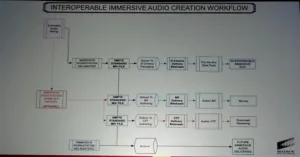At NAB 2015, DTS announced a new immersive sound solution aimed at theaters as well as consumer use called DTS:X. This appears to be a re-branding of the company’s previously developed Multi-Dimensional Audio (MDA) platform. In theaters, it will now compete directly with Barco’s Auro3D and Dolby Atmos, and indirectly with IMAX and its current 6-channel and soon to be released 12-channel immersive sound solution. DTS also says the technology will be used in home AVR platforms as well (for more details see “DTS:X Brings Object-based Audio For Cinema & Home“). But within hours, we learned that Dolby revealed to the SMPTE committee on immersive sound that it was opening it up to proprietary bitstream for adoption as a standard, a move aimed at making its approach the de facto standard.
The DTS:X solution is a bit different from the Auro3D and Atmos solutions in its ability to use any speaker configuration, not the pre-set configurations of the Auro3D and Atmos. That could offer it a big leg-up as many exhibitors are now having to either commit to Barco, Dolby or stay on the fence until some standardization comes along.
The whole idea of immersive sound is to move beyond the traditional single-level 5.1 or 7.1 surround sound solutions to add both a height component to the sound and the ability to make sounds appear to come nearly any point in the domed space above the audience.
Barco does this with an 11.1 solution that is basically a double-stacked 5.1 solution with an overhead channel. Dolby does it with an array of speakers all around the theater. IMAX is now increasing its channels from 6 to 12 to deliver a more precise immersive sound solution.
MDA is DTS’s license fee-free contribution to the professional audio community for mixing and storage of immersive audio content. The DTS:X licensing program is for cinema operators to allow them the opportunity to provide their audience with an immersive sound experience. To ensure quality and provide flexibility within the DTS:X program, DTS has partnered with server, sound rendering and processing companies. GDC Technology, QSC and USL, have developed and made available DTS:X-ready components that process and render MDA files.
For home theater AVRs, DTS announced that manufacturers representing nearly 90% of the home AVR and surround processor market will launch DTS:X-enabled products beginning in early summer 2015, with additional manufacturer and model announcements to follow in the coming months. Confirmed AVR partners include: Denon, Integra, Marantz, Onkyo, Pioneer, Steinway Lyngdorf, Theta Digital, Trinnov Audio and Yamaha.
DTS:X solutions are also available for 2015 AV receiver silicon platforms representing the majority of the DSP platform market share, including Cirrus Logic, Analog Devices and Texas Instruments.
At the Technology Summit on Cinema, there was a panel session that discussed immersive sound from a sound mixers’ perspective, studio perspective and standardization perspective. Brian Vessa represented Sony Pictures and he is also chair of the SMPTE committee looking at standardizing immersive audio. Will Files is a sound mixer at Skywalker Sound.
Clearly, one of the biggest concerns of the studios, sounds mixers and exhibitors is the number of competing solutions in the market today. Each solution from IMAX, Dolby, Barco and DTS is incompatible with the others. That means movies have to be mixed separately for IMAX (6 and 12-channel), Auro3D, Atmos, DTS:X and 5.1 and 7.1. That’s a lot of extra work that the studios don’t want to pay for. In addition, there is no standard for archiving of immersive audio, so studios must archive all versions, which is not efficient.
From the exhibitor perspective, they have to commit to one of these solutions, which does not afford them much flexibility. Rendering solutions are unique as are the speaker configurations and calibration procedures.
In his presentation, Vessa laid out what the SMPTE committee is trying to do to develop a standard that can allow some interoperability between these competing solutions. Started in October 2012 and called TC-25CSS, Vessa’s committee has issued a report and continues to meet on a regular basis to develop the proposed standard. He is optimistic that it will be available by the end of 2015.
Vessa says that the team is focused on developing a standard for a bitstream that would contain the sounds as well as the instruction the sounds mixer used with faders and joysticks to create the desired immersive effects. This is called the SMPTE Standard Mix File in the workflow diagram below. That means one immersive compatible mix that can be used to derive company specific implementation at the theater, plus other derivatives like the Blu-ray master or streaming files.
Vessa says this approach maintains the industry’s ability to innovate and offer alternative solutions. To translate the standard mix file at the theater into a Dolby, Barco or DTS mix would be an automated process that could be done in the Integrated Media Block (IMB).
But mix engineer Will Files is not so sure this is feasible. He noted that when he does a mix with Dolby Atmos, he uses the location of the speakers, their sound pressure levels and more to create a mix that is adapted to the characteristics of the speakers. Different speakers have different responses and pressure levels, which he is not sure can be automatically transformed by an algorithm.
Vessa says this concern is being echoed in the committee meetings and one of the things they are working on is a reference rendering solution for the theaters to show how this will work. He hopes this can be demonstrated by the end of the year.
Analyst Comment
Clearly, there is much more work to be done to develop this standard, but with economics driving the need, it will find support among many key players. However, with Dolby now offering its bitstream format as a standard, studios and exhibitors may rally behind it. This will open up more companies to make in-theater processors that support the Dolby bitstream, expanding competition, something exhibitors will like. (CC)

